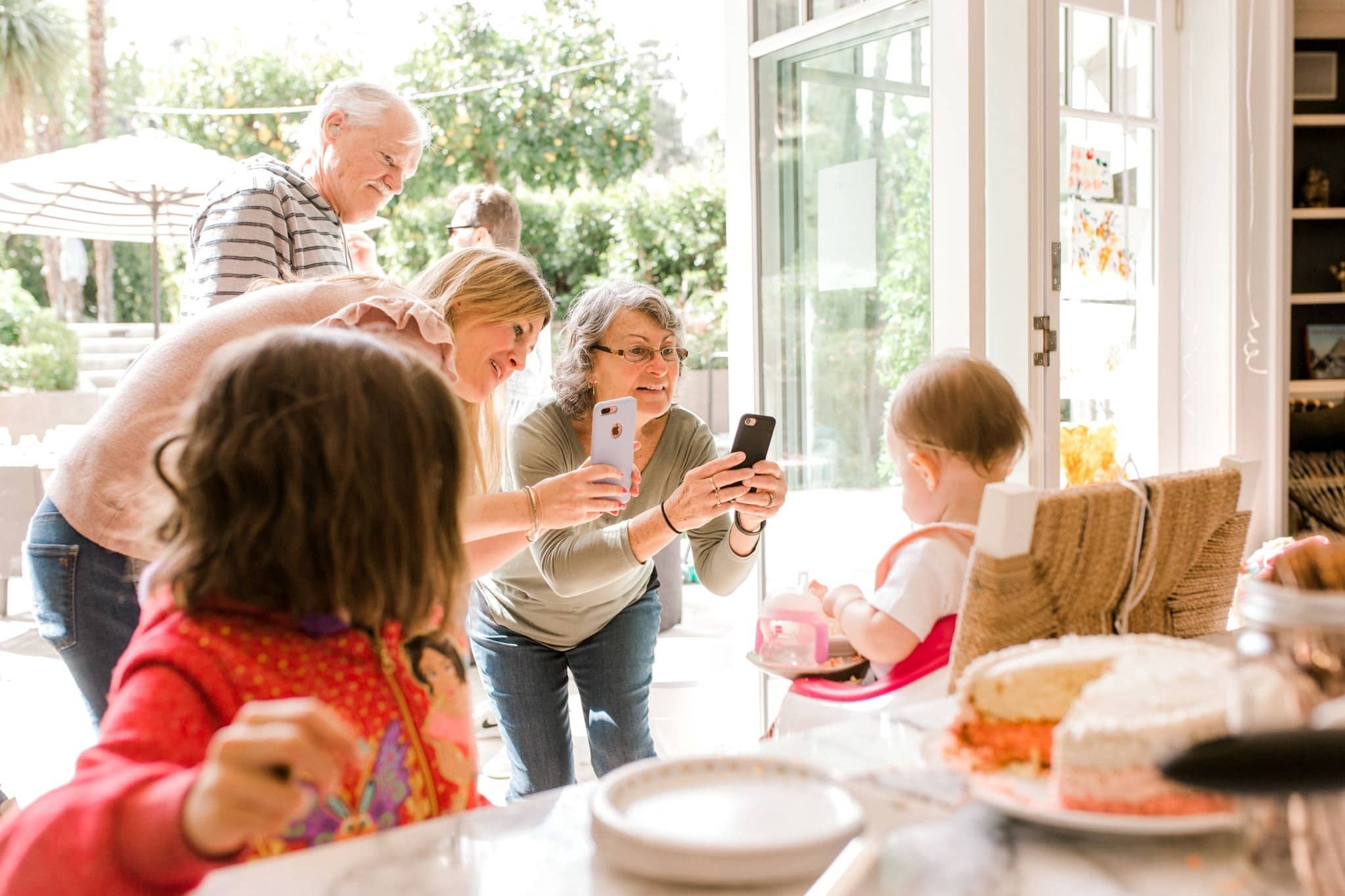What’s the harm in posting about our kids on social media?

@mister_pretty_pictures via Twenty20
There's a thin line between sharing and oversharing when it comes to documenting our children's lives online.
Table of Contents
Can you think of a more irresistibly photogenic creature than your dimpled baby triumphantly hoisting a plump fist full of birthday cake? Or any subject more close-up-ready than your unsteady toddler taking their first steps?
So with a camera always just a few swipes away, these are the kind of moments many of us capture without a thought. And often, without a second thought, we take the extra minute to share these memories online. After all, what parent could resist?
This instinct is a normal one—and one that existed well before the dawn of the internet. “Remember Grandma’s brag books? Parents and grandparents always feel the need to share,” says Pamela B. Rutledge, PhD, Director at Media Psychology Research Center.
Sharing gives us a way of appreciating or savoring the experience with the bonus of getting social validation, Rutledge says. “Sharing can also be a way of normalizing one’s experience as a parent — feeling like you are doing things the right way; reaffirming your identity as a parent.”
However, even though we’re not alone in our desire to race to the virtual rooftops and shout the most adorable aspects of our kids’ lives (one survey found that 30% of parents post a photo or video of their child at least once a day), this urge directly conflicts with the cautionary tales we hear about the internet’s darkest corners. Tougher still can be pinpointing which risks are real and which are internet lore (remember the Momo challenge hoax?).
As parents, the world, and particularly the internet, can feel like a scary place. But we can’t write the web off as wholly sinister — nor can we pretend like it’s a panacea. Because right now, we simply don’t know.
Millennial parents are essentially pioneers in this sweeping gray area that is parenting online. There is no roadmap. The best we can do is evaluate the information we do have and use it to make choices that align with our comfort level.
“It’s complex. We’re the first generation of parents to raise kids online, and our kids are the first generation to grow up under the watchful eyes of their parents’ newsfeed,” says Stacey Steinberg, a law professor at the University of Florida and author of the upcoming book Growing Up Shared. “So it’s this really unique generation that we’re trying to navigate, and there’s not a lot of data to drive our decision-making.”
We’ve been able to document our own lives online for the past 15 years or so. For many parents today, that’s only about half our lives or less. But our children’s social media presence may have pre-dated their births.
One study by internet security firm AVG found that 92 percent of children in the U.S. have an online presence before the age of two, and nearly a quarter of kids made their online debut before they entered the world thanks to ultrasound photos posted by their parents. And it’s important to note that this research came out in 2010. For context, since then, Instagram has grown by an estimated million users to a billion. That’s potentially a lot more sonogram photos.
What’s the harm in sharing on social media?
Because the internet is forever shape-shifting and we have yet to see the long-term effects of our sharing right now, the line between sharing and oversharing is a moving target. Navigating this chasm starts with understanding the tangible risks involved with sharing online, so let’s break those down. The risks tend to fall into two categories:
1. Virtual theft
When you share something about your child online, you don’t have full control over who has access to that information or how they’ll use it. Anything you share online has the potential to be viewed by anyone anywhere in the world, warns Rebecca Herold, an information security, privacy, and compliance consultant and CEO at The Privacy Professor. “As long as one other person online has access to your child’s photo or video, you are trusting that they are not going to take that photo and share it in ways that you would not want them to,” she says.
Probably the least threatening manifestation of this is that companies are constantly collecting information on all of us — including our children — so they can better target us with advertisements. At the most nefarious end of the spectrum, sometimes innocent photos of children are stolen to be used for illicit purposes.
Then, of course, there’s identity theft, which is becoming a real threat thanks to the sheer volume of information available online. In 2018, the bank Barclay’s forecasted that parents sharing personal information about their children online will account for two-thirds of identity fraud by 2030.
“Babies are common targets because their identities can be criminally used for many years before your child reaches an age where they will be applying for a loan, credit card, etc, and subsequently discover they’ve been an identity theft victim,” Herold says.
According to Barclay’s the pieces of information that make your child most vulnerable to identity fraud are: full name, home address, and birthdate. Chances are, you aren’t straight up Tweeting your social security number, but you may be revealing more than you think with an online birth announcement that details your child’s full name and birthdate or a geotagged photo that gives away your home address.
2. Your child’s digital legacy
Another important consideration for parents is their child’s digital footprint, Steinberg says. Parents may be posting for years, shaping their child’s digital reputation, before their child fully grasps the concept of online sharing and how to construct their own identities publicly.
When kids are old enough, they may feel exposed since these images were posted without consent and want to take back control of their images, Rutledge says. “One difficult issue is the boundary between parent and child. Parents share what their kids do as a reflection of their role as a parent. In many cases, this is about the parent more than the child,” she explains. “At the same time, these are the child’s images that are being posted and shared.” She adds that by posting images, not only do parents make them searchable, but they also might unintentionally giving another party permission to reuse them.
Share smarter on social media
“While there are concerns, I’m in no way suggesting parents stop sharing altogether,” Steinberg says. “I’m suggesting they make well-informed choices with regards to what they share.”
Take a look at the privacy policies on the social media platforms you use. “Review the site’s terms and conditions, sometimes hidden within the site’s privacy notice/policy, to understand the specific types of data that is collected when you post,” Herold says.
While you’re at it, check the settings on your devices. “Find out how much information is being saved on that device and how much is being shared,” says Denise Lisi DeRosa, an online safety expert and founder of Cyber Sensible. “You want to make sure you’re not always sharing your exact location, which could be your home address.”
And there are certain things experts advise not posting at all:
- Pictures of your child in any state of undress. Images like this could make your child a target for predators. “Maybe your child is wrapped in a towel or the towel is half off. That’s a cute photo to share with Grandma — not with Facebook,” DeRosa says.
- Identifying details. This includes location information that might give away where you live or where your child attends school.
- Something that may be embarrassing later. This one is totally subjective, but consider how your child might feel in the future. “Even though it’s cute now, it might not be cute in five or 10 years when their friends see it,” DeRosa says. Aired grievances may also not age well. Think about whether or not this is something you’d share publicly offline. “I wouldn’t walk into a movie theater and stand up and shout, ‘I’m trying to potty train, does anybody have suggestions?'”
Give your kids a say in sharing
As soon as your children are old enough — around 5 or 6 — engage them in conversations about what you share, and as they get older, give them veto power over what information is shared, Steinberg says.
Having a conversation is always a good idea, but it has to be age-appropriate, Rutledge adds. “A 4-year-old is not going to understand what it means to have images public,” she says. “They might understand the intention of putting a picture where Grandma can see it, but they won’t understand that, in five years, someone may find a picture and tease them about it. The conversation should continue periodically.”
One place to start might be right after you take a photo. As you look at that picture, talk to your child about where it might be going. If you post it and someone leaves a comment, let them read it and give them a chance to respond, Steinberg says. Inviting your child to look at social media with you gives them training wheels before they ride solo with their own accounts. It’s an opportunity for you to model courtesy and responsible online behavior.
And as you share some of the consequences of sharing online, you can also share the positives with your children. “It’s really important for parents to talk about [the] many benefits of sharing. It helps us connect with family and friends who live far away. It helps us build our communities and online relationships and networks, Steinberg says. “There’s a lot of power in our narrative when we share our vulnerabilities. So many good things come from sharing online, and I never want to silence a parent’s voice.”
Ultimately, you have to weigh the risks and benefits and make the decision that feels right for you and your family, whether that means going analog with your photo-sharing and filling the plastic-coated pages of an old-school brag book or documenting your child’s daily life — or falling somewhere in between — is up to you.
“Just as we have regular conversations about how we feed our kids and discipline our kids, we need to have more regular conversations about how we share about our kids,” she says. “There are more questions than there are answers, so this isn’t about judging, it’s about trying to move the conversation forward.”
This story originally appeared on Apparently.





































